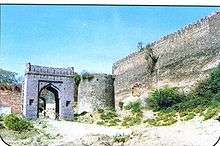Mandsaur Fort
Mandsaur Fort, also known as Dashpur fort, is situated in Mandsaur city in Mandsaur district in Madhya Pradesh state of India. [1]

Strategic importance
The Mandsaur city is situated on the border of Malwa and Mewar and as such was strategically very important. After the attack of Timur, the Delhi Sultanate became weak. Dilawar Khan Ghauri was governor of the Malwa province of central India during the decline of the Delhi Sultanate. Dilawar Khan declared himself Sultan of Malwa in 1401, and passed the kingdom to his son Hoshang Shah upon his death. Thus he had practically come to Mandu in 1401 as the first King of Malwa. Dilawar had also shifted the capital from Dhar to Mandu, renaming it Shadiabad, the city of joy. The successor of Dilawar Khan Gauri was Hushang Shah Gori (1405-1435), who constructed fort at strategically important Mandsaur city to strengthen his north-west boundary. [2] He is also remembered for his wonderful taste in architecture. It was he who made Mandu one of the most impregnable forts of India. The Sisodia rulers of Mewar by this time were becoming strong. Mandsaur fort was mainly associated with Mandu rulers. [3]
In 1519 Rana Sanga occupied the fort and appointed Ashokmal Rajput as its Kiledar, Ashokmal was killed in the Siege of Mandsaur against the armies of Malwa and Gujarat, however the fort did not fall, forcing the besiegers to retreat. In 1535 Humayun also stayed here for few months during his Malwa expedition. During Sher Shah period Sadar Khan was appointed its Kiledar. [4] During the reign of Akbar Mandsaur got the status of sarkar. In 1733 the Malwa subedar of Mughals Sawai Jaisingh attacked the fort but was defeated by Marathas and the fort went to Marathas. [5] The historically most important event in the fort was the treaty of 1818 between Tantiya Jog senapati of Malhar Rao Holkar II and Sir John Malcum under which Malwa came in occupation of British rule. [6] [7]
Construction
The fort has twelve gates. It is surrounded by an outer wall. The south-east gate is known as Nadi Darwaja. On the side of this gate is an inscription which reveals that it was constructed by an army officer Mukbil Khan in 1490 during the tenure of Giyas Shah (1469-1500).
Modern days
The Fort premises are nowadays used as office by collector, District Judge and other Govt officers. There are two gardens in which there is a pillar of torandwar. It is believed to be pillar of Surya Mandir of the inscription of Bandhu Varma. There is a Shiva statue also in the garden. [8]
References
- Usha Agarwal:Mandsaur Zile ke Puratatvik samarakon ki paryatan ki drishti se sansadhaniyata - Ek Adhyayan, Chrag Prakashan Udaipur, 2007, p. 18
- Sikandar bin Mahmud:Mirat-e-Sikandar, p. 113
- Usha Agarwal:Mandsaur Zile ke Puratatvik samarakon ki paryatan ki drishti se sansadhaniyata - Ek Adhyayan, Chrag Prakashan Udaipur, 2007, p. 18
- H.Mikal Brown (Ed): Gwalior Today, 180
- Raghuvir Singh:Madhyakalin Mandsaur mien huee Bharatiy Itihas ki kuchh nirnayak ghatnaen, p. 12
- Mandsaur district gazetteer, p. 42
- Usha Agarwal:Mandsaur Zile ke Puratatvik samarakon ki paryatan ki drishti se sansadhaniyata - Ek Adhyayan, Chrag Prakashan Udaipur, 2007, p. 19
- Usha Agarwal:Mandsaur Zile ke Puratatvik samarakon ki paryatan ki drishti se sansadhaniyata - Ek Adhyayan, Chrag Prakashan Udaipur, 2007, p. 19
